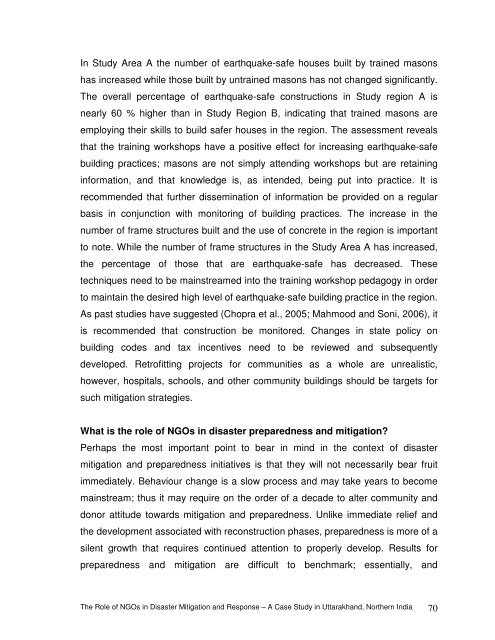A Case Study in Uttarakhand, Northern India - Geological & Mining ...
A Case Study in Uttarakhand, Northern India - Geological & Mining ...
A Case Study in Uttarakhand, Northern India - Geological & Mining ...
- No tags were found...
Create successful ePaper yourself
Turn your PDF publications into a flip-book with our unique Google optimized e-Paper software.
In <strong>Study</strong> Area A the number of earthquake-safe houses built by tra<strong>in</strong>ed masonshas <strong>in</strong>creased while those built by untra<strong>in</strong>ed masons has not changed significantly.The overall percentage of earthquake-safe constructions <strong>in</strong> <strong>Study</strong> region A isnearly 60 % higher than <strong>in</strong> <strong>Study</strong> Region B, <strong>in</strong>dicat<strong>in</strong>g that tra<strong>in</strong>ed masons areemploy<strong>in</strong>g their skills to build safer houses <strong>in</strong> the region. The assessment revealsthat the tra<strong>in</strong><strong>in</strong>g workshops have a positive effect for <strong>in</strong>creas<strong>in</strong>g earthquake-safebuild<strong>in</strong>g practices; masons are not simply attend<strong>in</strong>g workshops but are reta<strong>in</strong><strong>in</strong>g<strong>in</strong>formation, and that knowledge is, as <strong>in</strong>tended, be<strong>in</strong>g put <strong>in</strong>to practice. It isrecommended that further dissem<strong>in</strong>ation of <strong>in</strong>formation be provided on a regularbasis <strong>in</strong> conjunction with monitor<strong>in</strong>g of build<strong>in</strong>g practices. The <strong>in</strong>crease <strong>in</strong> thenumber of frame structures built and the use of concrete <strong>in</strong> the region is importantto note. While the number of frame structures <strong>in</strong> the <strong>Study</strong> Area A has <strong>in</strong>creased,the percentage of those that are earthquake-safe has decreased. Thesetechniques need to be ma<strong>in</strong>streamed <strong>in</strong>to the tra<strong>in</strong><strong>in</strong>g workshop pedagogy <strong>in</strong> orderto ma<strong>in</strong>ta<strong>in</strong> the desired high level of earthquake-safe build<strong>in</strong>g practice <strong>in</strong> the region.As past studies have suggested (Chopra et al., 2005; Mahmood and Soni, 2006), itis recommended that construction be monitored. Changes <strong>in</strong> state policy onbuild<strong>in</strong>g codes and tax <strong>in</strong>centives need to be reviewed and subsequentlydeveloped. Retrofitt<strong>in</strong>g projects for communities as a whole are unrealistic,however, hospitals, schools, and other community build<strong>in</strong>gs should be targets forsuch mitigation strategies.What is the role of NGOs <strong>in</strong> disaster preparedness and mitigation?Perhaps the most important po<strong>in</strong>t to bear <strong>in</strong> m<strong>in</strong>d <strong>in</strong> the context of disastermitigation and preparedness <strong>in</strong>itiatives is that they will not necessarily bear fruitimmediately. Behaviour change is a slow process and may take years to becomema<strong>in</strong>stream; thus it may require on the order of a decade to alter community anddonor attitude towards mitigation and preparedness. Unlike immediate relief andthe development associated with reconstruction phases, preparedness is more of asilent growth that requires cont<strong>in</strong>ued attention to properly develop. Results forpreparedness and mitigation are difficult to benchmark; essentially, andThe Role of NGOs <strong>in</strong> Disaster Mitigation and Response – A <strong>Case</strong> <strong>Study</strong> <strong>in</strong> <strong>Uttarakhand</strong>, <strong>Northern</strong> <strong>India</strong> 70
















